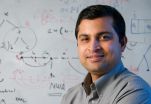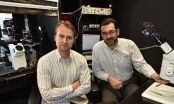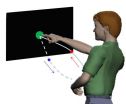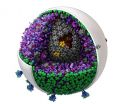Study: Different species share a 'genetic toolkit' for behavioral traits
2014-12-01
(Press-News.org) CHAMPAIGN, Ill. -- The house mouse, stickleback fish and honey bee appear to have little in common, but at the genetic level these creatures respond in strikingly similar ways to danger, researchers report. When any of these animals confronts an intruder, the researchers found, many of the same genes and brain gene networks gear up or down in response.
This discovery, reported in the Proceedings of the National Academy of Sciences, suggests that distantly related organisms share some key genetic mechanisms that help them respond to threats, said University of Illinois cell and developmental biology professor Lisa Stubbs, who led the research with animal biology professor Alison Bell and entomology professor and Institute for Genomic Biology director Gene Robinson. Bell and Stubbs also are IGB faculty.
"We knew that a variety of animals share genes for some common physical traits. Now it appears that different organisms share a 'genetic toolkit' for behavioral traits, as well," Stubbs said.
The team used comparative genomics to look at changes in brain gene expression in the house mouse (Mus musculus), stickleback fish (Gasterosteus aculeatus) and honey bee (Apis mellifera) in response to intrusion by a member the same species.
"One of the striking findings is that elements of the brain gene-expression response to a territorial intrusion were common to all three species, despite vast differences in brain anatomy among the three," Bell said. "This is meaningful because it suggests that molecular similarities run deeper than brain structural similarities."
All three species saw changes in the expression of genes that regulate hormones and neurotransmitters that are known to influence behavior. Other shared responses involved genes that contribute to brain developmental processes; metabolic genes; genes related to muscle contraction and blood supply; and genes associated with the formation of synapses, the growth of neurons and the differentiation of glial brain cells.
"To find common sets of activated genes, in species that evolved their behavioral responses to intruders hundreds of millions of years apart from each other, gives hope that scientists will be able to make use of comparative genomics to better understand how the behaviors of different species relate to each other, and to ourselves," Robinson said.
INFORMATION:
The Simons Foundation supported this research.
To reach Lisa Stubbs, call 217-244-4000; email ljstubbs@illinois.edu.
To reach Alison Bell, call 217-265-5469; email alisonmb@illinois.edu.
To reach Gene Robinson, call 217-265-0309; email generobi@illinois.edu.
The paper, "Neuromolecular responses to social challenge: Common mechanisms across mouse, stickleback fish and honey bee," is available from the U. of I. News Bureau.
[Attachments] See images for this press release:


ELSE PRESS RELEASES FROM THIS DATE:
2014-12-01
The rapid evolution of HIV, which has allowed the virus to develop resistance to patients' natural immunity, is at the same time slowing the virus's ability to cause AIDS, according to new research funded by the Wellcome Trust.
The study also indicates that people infected by HIV are likely to progress to AIDS more slowly - in other words the virus becomes less 'virulent' - because of widespread access to antiretroviral therapy (ART).
Both processes make an important contribution to the overall goal of the control and eradication of the HIV epidemic. In 2013, there ...
2014-12-01
The most commonly used medications for osteoporosis worldwide, bisphosphonates, may also prevent certain kinds of lung, breast and colon cancers, according to two studies led by researchers at the Icahn School of Medicine at Mount Sinai and published today in the Proceedings of the National Academy of Sciences (PNAS).
Bisphosphonates had been associated by past studies with slowed tumor growth in some patients but not others, and the mechanism behind these patterns was unknown. In the studies published today, an international research team showed that bisphosphonates ...
2014-12-01
Any science textbook will tell you we can't see infrared light. Like X-rays and radio waves, infrared light waves are outside the visual spectrum.
But an international team of researchers co-led by scientists at Washington University School of Medicine in St. Louis has found that under certain conditions, the retina can sense infrared light after all.
Using cells from the retinas of mice and people, and powerful lasers that emit pulses of infrared light, the researchers found that when laser light pulses rapidly, light-sensing cells in the retina sometimes get a double ...
2014-12-01
INDIANAPOLIS and NEW BRUNSWICK, N.J. -- Imperceptible variations in movement patterns among individuals with autism spectrum disorder are important indicators of the severity of the disorder in children and adults, according to a report presented at the 2014 Society for Neuroscience annual meeting in November.
For the first time, researchers at Indiana University and Rutgers University report developing a quantitative way to assess these otherwise ignored variations in movement and link those variations to a diagnosis.
"This is the first time we have been able to explicitly ...
2014-12-01
Two years ago, researchers at the U.S. Department of Energy's Joint BioEnergy Institute (JBEI) engineered Escherichia coli (E. coli) bacteria to convert glucose into significant quantities of methyl ketones, a class of chemical compounds primarily used for fragrances and flavors, but highly promising as clean, green and renewable blending agents for diesel fuel. Now, after further genetic modifications, they have managed to dramatically boost the E.coli's methyl ketone production 160-fold.
"We're encouraged that we could make such a large improvement in methyl ketone ...
2014-12-01
In a remarkable collaborative effort between human and veterinary clinicians, a 29-year-old bottlenose dolphin recently underwent therapeutic bronchoscopy to treat airway narrowing, or stenosis, that was interfering with her breathing. The dolphin, a therapy animal for mentally and physically challenged children at Island Dolphin Care in Key Largo, Florida, is doing well one year after the procedure.
"Many of the medical treatments and procedures used in humans were developed and tested in animals, and many are used in the care of both," said lead author Andrew R. Haas, ...
2014-12-01
MADISON, Wis. -- In 1997, IBM's Deep Blue computer beat chess wizard Garry Kasparov. This year, a computer system developed at the University of Wisconsin-Madison equaled or bested scientists at the complex task of extracting data from scientific publications and placing it in a database that catalogs the results of tens of thousands of individual studies.
"We demonstrated that the system was no worse than people on all the things we measured, and it was better in some categories," says Christopher Ré, who guided the software development for a project while a UW ...
2014-12-01
MADISON, Wis. -- If Brad Singer knew for sure what was happening three miles under an odd-shaped lake in the Andes, he might be less eager to spend a good part of his career investigating a volcanic field that has erupted 36 times during the last 25,000 years. As he leads a large scientific team exploring a region in the Andes called Laguna del Maule, Singer hopes the area remains quiet.
But the primary reason to expend so much effort on this area boils down to one fact: The rate of uplift is among the highest ever observed by satellite measurement for a volcano that ...
2014-12-01
ANN ARBOR--As much as two-thirds of Earth's carbon may be hidden in the inner core, making it the planet's largest carbon reservoir, according to a new model that even its backers acknowledge is "provocative and speculative."
In a paper scheduled for online publication in the Proceedings of the National Academy of Sciences this week, University of Michigan researchers and their colleagues suggest that iron carbide, Fe7C3, provides a good match for the density and sound velocities of Earth's inner core under the relevant conditions.
The model, if correct, could help ...
2014-12-01
LA JOLLA, CA - December 1, 2014 - Researchers can now explore viruses, bacteria and components of the human body in more detail than ever before with software developed at The Scripps Research Institute (TSRI).
In a study published December 1 in the journal Nature Methods, the researchers demonstrated how the software, called cellPACK, can be used to model viruses such as HIV.
"We hope to ultimately increase scientists' ability to target any disease," said Art Olson, professor and Anderson Research Chair at TSRI who is senior author of the new study.
Putting cellPACK ...
LAST 30 PRESS RELEASES:
[Press-News.org] Study: Different species share a 'genetic toolkit' for behavioral traits





